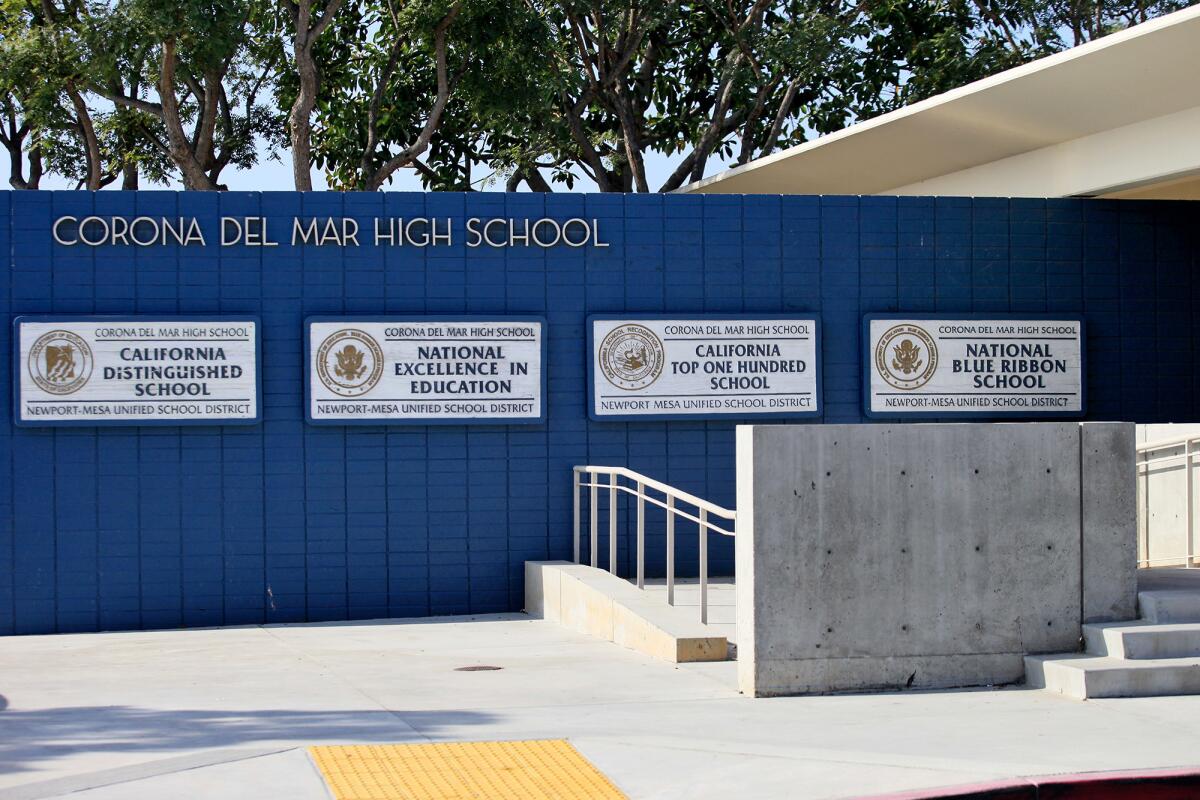Newport-Mesa Unified drafts a plan for how secondary schools might work in a ‘new normal’

- Share via
Though Orange County schools may have to reopen remotely next month, given the ongoing coronavirus pandemic, Newport-Mesa Unified officials on Tuesday approved a plan for how secondary students could return to campuses if and when it’s safe.
A 100% virtual K-12 school option has been created for all district parents wishing to keep kids at home. Now officials are considering how the rest might learn in a flexible model that would shift in response to state and county reopening guidelines, from in person to hybrid to online, in either direction.
A TK-6 plan was adopted by board members last week. But accommodating a panoply of high school offerings — electives, AP courses, progressive math classes and world languages — in a modified schedule, and then layering in disinfection and social-distancing protocols that satisfy ever-changing health directives, has proven daunting.
Administrators and staff have worked for weeks to find a flexible learning plan that can meet health and safety criteria, while also addressing the social-emotional and academic needs of a diverse student body in any learning environment.
Enter the 4x4 model.
A form of block scheduling, the model would have most middle and high school students taking half their courses in the fall semester and half in the spring. Class periods would be held five days per week, allowing for a deeper dive into the subject matter.
There are some exceptions. Early College High School students would have their own hybridized traditional model to sync with Coastline Community College, where they attend classes. And Back Bay/Monte Vista High would operate under a more traditional schedule.
The 4x4 model would set the tone for the school day, whether classes were 100% in-person, 100% online or if kids were able to come to campus in a modified capacity as part of a hybrid model.
Under the hybrid plan, to reduce class sizes, students would be divided into morning and afternoon cohorts that would receive socially distanced instruction for half a day and then participate in extended learning, likely at home, for the remainder of the day. Special education students in the hybrid model would receive a full day of instruction.
“I want to encourage everybody to keep a very open mind, because this is a very different model,” Interim Supt. Russell Lee-Sung said Tuesday in a special board meeting that inspired more than 330 public comments before it began.
Several speakers, including student board member and Corona del Mar incoming senior Troy Tsubota, expressed concern the 4x4 model would create logistical problems.
For example, wouldn’t condensing a yearlong class into one semester cause burnout? And how could AP students who took courses in the fall be expected to pass exams in May?
“It is scientifically proven that learning over a longer period is more effective, with retention, than cramming it into a shorter period,” Tsubota said, adding most Corona del Mar teachers, students and parents overwhelmingly oppose the plan. “Now is not the time to introduce a completely new course schedule.”
A panel of educators and principals explained the new model would have teachers seeing students for more time in a semester because classes would held daily.
Courses would not be “sped up” because having classes each day would give students more time on one subject than the current model, where students take six to eight classes but not every day, instead alternating between the two groups of courses in a given week.
“With 4x4, they’re seeing their teacher every single day,” said Newport Harbor High School science teacher John Brazleton. “For that struggling student to have only three courses they need to focus on, that they could focus on every day — this schedule could definitely help a huge swath of the population.”
It would also reduce the number of students for which a teacher would be responsible, allowing for deeper connections between students and teachers, said Costa Mesa High math teacher Rachel Kloppenburg.
“When I think about starting the school year online, which is looking more likely, it’s going to be far easier for me to get to know 90 students on Zoom than 180,” she said. “For me to be an effective teacher I need to know my students’ personalities. I need to know their learning styles.”
Kloppenburg also assured Tsubota AP teachers would continue to offer robust review sessions in April, whether online or in person.
Board members ultimately approved the 4x4 model in a 5-2 vote, assuring logistical issues like transportation and trying to keep siblings at different schools on the same learning schedule would be worked out in the weeks ahead.
Trustees Karen Yelsey and Michelle Barto opposed the plan, which they said seemed too much of a change to make in too short a time and could put AP and International Baccalaureate students at a disadvantage.
“I just think it takes a lot longer to get this right than we’re giving it time for,” Yelsey said.
The new academic year begins Aug. 24.
For the Record: An earlier version of this article incorrectly stated class periods would be longer under the newly adopted 4x4 model than under the traditional course schedule. Each class will be shorter, but it will be held daily.
All the latest on Orange County from Orange County.
Get our free TimesOC newsletter.
You may occasionally receive promotional content from the Daily Pilot.










